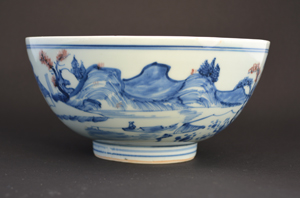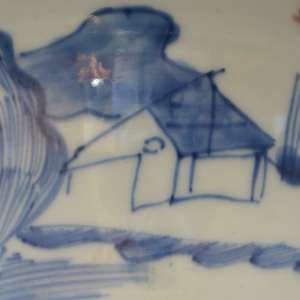
Unusual Early Kangxi Blue and White with Copper Red Porcelain Bowl
An Unusual Early Kangxi Blue and White with Copper Red Porcelain Bowl in Master of the Rocks Style c.1670. The Well Painted Thickly Potted Porcelain Bowl is Painted with a Typical Master of the Rocks Subject, an Extensive Landscape with a Building Nestled Against Large Angular Rocks with a Small Fishing Vessel with Ranges of Mountains and Trees Leading up to the Shoreline.
SOLD
- Condition
- In poor condition but well repaired : a large rim crack c.62 mm, another c.48 mm. A 'U' shaped chip to the outside rim c.22 x 7 mm, a chip to the inside rim c.12 x 4 mm, another c.17 x 3 mm. A glaze chip c.18 x 3 mm.
- Size
- Diameter : 19.5 cm (7 3/4 inches)
- Provenance
- N/A
- Stock number
- 24441
Information
Copper-red occurs quite frequently on Master of the Rocks designs from the early Kangxi period but small bowls like the present example are more unusual. The painting style of the present example is typical and includes small sold circular marks made with the end of a wet brush..
The Master of the Rocks Style :
The phrase Master of the Rocks is unfamiliar to many Chinese, it is another invented category used by western scholars and collectors to pigeon-hole groups of Chinese ceramics, rather like Kraakware or Celadon. However unlike either of these Master of the Rocks first coined by Gerald Reitlinger, is a clear, distinct group. This style lasted from about 1645 to 1690. The highly distinctive painting style consists of landscapes with massive powerful mountains in a linier technique. The style is, for want of a better word, ‘painterly’ and often includes distant mountains painted with a very wet brush that contrast with the linier mountains in the mid ground. The style usually employs a technique of blobby dots, either in the landscape or as a border. These dots are painted with a wet brush and have no outline. These designs were certainly inspired by late Ming scroll painters like Wang Jinazhng (active c.1628 – 1644). The same use of brush strokes in contour like parallels lines can be seen. Mountains with jagged peaks are piled up creating a dramatic structure. But where as many of the scroll painters are known, the ceramics artists are anonymous.







